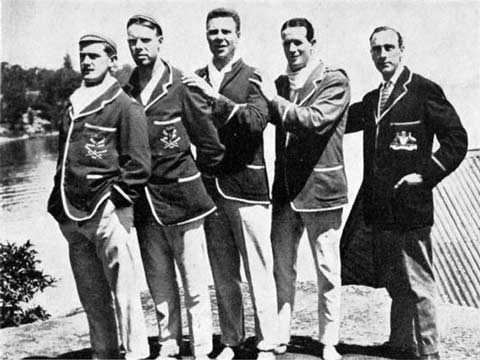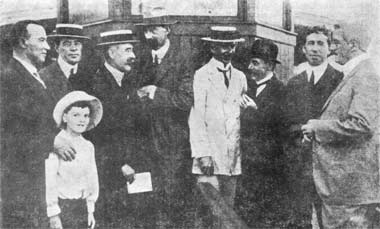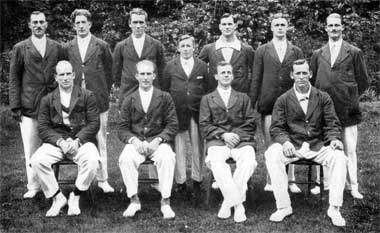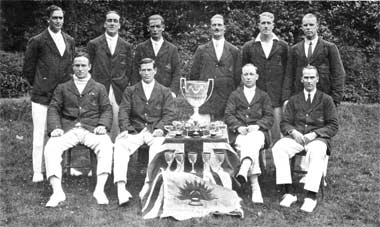
Sydney Rows
A Centennial History of the Sydney Rowing Club, 1970, by A L May
Table of Contents
Chapters
- Preliminaries: before 1870
- Foundations: 1870-1880
- New Clubs: 1880-1890
- The Amateur Question: 1890-1900
- Sydney on Top: 1900-1910
- Henley and War: 1910-1920
- Pearce and Mosman: 1920-1930
- Financial Problems: 1930-1940
- War and Wood: 1940-1950
- Strength and Stability: 1950-1960
- On Top Again: 1960-1970
Appendices
6. Henley and War: 1910-1920
The 1912/13 rowing season was much less exciting but not wholly without interest. An Enterprise junior four and a Leichhardt sculler visited Henley-on-Yarra (their travel costs paid by the organising committee) and, though not successful, the Enterprise crew returned to Sydney to win the champion fours of NSW. Sydney had no entry, none of its Olympians yet training again.
Middleton and Heritage rowed in the club's senior eight for the championships in December, 1912 (along with Charles Wellesley, W. Tymms, Allan Audsley, J. J. Gunning, W. D. Scott and Rex Rabett), but the crew was beaten by just over a length by Balmain (its crew including Parker and Amess). Green ( Enterprise ) won the sculls once again. Fitzhardinge, McDonald and McGregor were chosen as selectors for the 1913 State eight, but they found only Amess of the Olympic squad available for selection.
Two other Balmain oarsmen (including Green at stroke), three from Enterprise , one from Leichhardt and Audsley from Sydney completed the crew, while Rabett was made emergency. With Bill Middleton unavailable, George Gunning of North Shore (and formerly of Melbourne ) was chosen coach.
The interstate race itself, rowed in Adelaide , was "an absolute fiasco". Weather conditions were "totally unfit for best-boat racing", with a strong westerly blowing across the river. After a long delay, the race began and NSW was slightly ahead after 300 yards when a poppet cord broke. At the mile mark, SA, represented by Murray Bridge oarsmen, caught Tasmania and took the lead. They finally won by 200 yards from Tasmania . Victoria sank just before the 2 mile mark while Tasmania "just crept over the line, prior to sinking altogether". The coxswain of the winning crew steered with one hand and bailed with the other. Queensland also failed to finish, but the WA crew paddled ashore, emptied their boat, got afloat again and rowed across the line to finish third, about five to six minutes behind Tasmania.
Coverdale of Tasmania beat Marr of Queensland - the only other competitor - in the sculls. McVilly had remained overseas - and fully made amends for his previous performances by winning the Diamond Sculls at the 1913 Royal Henley.
Consideration had been given meanwhile to conducting a Henley-type regatta in NSW. The continued success of Victoria 's Henley-on-Yarra , the commencement of a Henley-on-Torrens in 1910 and of Henley-on-Brisbane in 1911 and, finally, the glory of the 1912 Henley Royal Regatta were, no doubt, important influences.
The canal at Leichhardt was suggested as suitable: it was 132 feet wide (wider than the Thames at Henley itself) and had a depth of 12 to 14 feet at high tide. An Association sub-committee recommended going ahead with the idea, but only if "a satisfactory arrangement in regard to enclosing sufficient of the land abutting on the Canal and acquiring the right to charge for admission thereto can be made". One other recommendation is of interest: "That it is imperative for the success of the scheme that the support of the social element of Sydney be secured". A deputation waited on the State Premier for support, but were later told no action could be taken until a planned railway scheme was completed. North Shore decided to stage a " Henley-on-Parramatta " instead, with eleven quick races on a short course from Putney to Gladesville. There was a fancy dress event as well, but the regatta was only moderately successful.

Sydney's senior four of 1913
Left to right: R L Rabett, W A Audsley, W D Scott, K L Heritage, R B Fitzhardinge (coach)
The champion fours of NSW was held at the regatta, over a longer course, and was won by Leichhardt from Balmain. Balmain chose the canal course for its regatta in November, 1913, and it was most successful with 3-4,000 people lining the banks. To raise funds for the 1914 interstate crew, a further regatta was held on Leichhardt canal and it, too, was a great success. Fitzhardinge, Heritage, Middleton and Barker turned out for Sydney in the senior eights event but proved very short of condition.

Boat race officials at the 1914 NSWRA regatta
Left to right: G McKenzie, A Thompson, N J McDonald, A Ramsay, J McGregor, J Blackman, G Gunning, V Horniman
NSW did very poorly in the 1914 interstate race. The champion eights had been won easily by Enterprise with Sydney 8 lengths back second. Leichhardt, which had beaten both crews at the SRC regatta, crashed into a beacon on the course. Balmain failed to start an eight and two of its interstate oarsmen, Amess and Holborn, rowed in the Enterprise crew. Alma Cox of Balmain, who earlier won the sculls at Henley-on-Yarra , won the champion sculls, while Leichhardt-with Tom McGill at 3-won the junior fours.
The State selectors were Fitzhardinge, McDonald and McGregor once again and they chose four Balmain men, including Amess, Cox and Holborn, two from Enterprise , one from Leichhardt and E. A. Cody of Sydney (who had joined the club after rowing with Mercantile in Melbourne ). Waley, now of Sydney , was cox, Audsley emergency and Gunning was coach. The race was rowed in Melbourne and NSW finished fifth. Tasmania narrowly beat SA and WA for the title in a very exciting and close race. A clash between NSW and SA led to the race being stopped and restarted. McVilly coached Tasmania and he also won the sculls "rather easily".
The first effects of the war now started to be felt. In August, 1914, just as the RA was announcing the dates approved for regattas for the coming season, enlistments commenced. Keith Heritage of Sydney was among the first to sign up. While the Association decided to carry on normal rowing for as long as was possible, North Shore and Sydney , which were to conduct the first two regattas, promptly cancelled them.
Thirteen Sydney members had enlisted in the Expeditionary Force by the middle of September. Five crews started, however, in the Association's champion fours in October, with Enterprise winning. Leichhardt was able to send a crew to a smaller Henley-on-Yarra for the Grand Challenge eights-the first time NSW had been represented-but they were beaten in a heat. Harry Green of Enterprise, who had stroked the club's champion four, won the champion sculls of NSW a fortnight later (Cox falling out of his boat) and, in December, Enterprise completed the treble by winning the champion eights from Leichhardt. Audsley and Eric Harrison were members of the Enterprise crew, while Green also made history by stroking it as well.
Sydney was rarely able to start crews in races and, in fact, scored exactly zero in both Association competitions for 1914/15. It was Queensland 's turn for the 1915 interstate race and, in November, 1914, the QRA asked other States what they thought should be done. "The Associations were unanimously of the opinion that the carnival should be postponed." In October 1915, the next race was further postponed until after the war.
The main rowing news for the duration of the war was the names of those enlisting, earning promotions and decorations and, unfortunately, being wounded or killed in battle. Strong support to the war effort was given by all clubs and Associations and lists appeared from time to time of enlistments. The Association's 1914/15 report "records with the highest appreciation the fact that rowing men responded nobly to the call for volunteers".
The 1916/17 report, in noting that competitions were again foregone, states that "our effort towards insuring the fullest possible representation by amateur oarsmen in the ranks of our Army fighting for freedom is still the first aim of the Association".
For SRC, by the end of the war, the number of past and present members enlisting totalled 91, of whom 21 paid the supreme sacrifice. The latter included Captain Keith Heritage, killed shortly after winning the Military Cross, Lt. A. C. H. Jackson, a member of the 1913 senior eight, Lt. Claude Luscombe, hon. secretary in 1915/16, and Sgt. F. Wellisch, hon. treasurer in 1914/15. Among members earning high honours were Lt. Col. Rex Rabett, who was awarded the C.M.G., Major Sid Middleton, winner of the D.S.O., and Captain Jack Goldie, winner of the Military Cross. Sydney 's experience was, of course, shared by other clubs in NSW and in other States. The number of oarsmen enlisting numbered several thousand, with several hundred failing to return. Many clubs were so reduced in members as to close down altogether. Among the many deaths was that of George Gunning, coach of the NSW eight in 1913 and 1914, who was killed at Gallipoli. Lt. P. V. Storkey, of Glebe, was decorated with the Victoria Cross, while Cecil McVilly was among winners of the Military Cross.
Some minor rowing continued in NSW during the war years, although the Association abandoned its premiership competition from 1915/16 to 1917/18. When it was decided that the absence of premiership points would not affect the status position, this was got around by the holding of "unclassified" races. The Anniversary Regatta and the St. Ignatius' Regatta were the only ones held until 1918, the former mainly to preserve the continuity of the event. At both, there was normally only one race for club oarsmen. Leichhardt, which had retained some strength, staged a regatta in April, 1918, and commenced a controversy by including an open race on the programme. Races for oarsmen under 20 were conducted at a number of regattas. In 1918/19, some normalcy returned, the junior pennant being reintroduced. The new Henley Rowing Club competed for the first time at the Association's regatta in March, 1919. The final regatta of the season was the Riverview Regatta at which Glebe, stroked by George Hancock, won the unclassified eights from Leichhardt.
Attention now turned again to Europe . There were reports of rowing amongst servicemen in London as early as September, 1916, and expectations soon developed of challenges when the war had successfully concluded. Members of the Australian forces took part in regattas in the English summer of 1917 and, at the end of that year, the "A.I.F. Wattle Club" was formed by members of the Australian Headquarters Staff in London .
Early in 1919, it was decided that a Henley Peace Regatta should be held in July and that races be included for amateur oarsmen of the Allied Armies. The French Rowing Association had already advertised a race on the Seine in April open to soldiers of the Allied Armies and, with two events in prospect, the AIF set about the task of collecting and sorting out its oarsmen. Fit, eager and experienced men were brought to London and, by March, training had commenced from London Rowing Club's shed at Putney.
A sub-committee was charged with the work of selection and coaching and it consisted of Lt. Ossie Wood, hon. secretary of the NSWRA, Lt. Harry Ross-Soden of the 1912 Olympic crew and Major E. W. Tulloch, a Victorian interstate representative. Stephen Fairbairn, captain of Thames , commenced the coaching, with Major Sid Middleton and then Lt.-Col. Norman Marshall taking over. Captain Clive Disher was selected as stroke and he, together with the rowing sub-committee and Lt. Harry Hauenstein, acted as selection committee.
It was decided to miss the Paris races, as they were being rowed in heavy clinkers without outriggers and the course was considered unsatisfactory. All efforts were concentrated on Henley . Two AIF crews were formed and entered for the big race while training rows took place between them. The no. 2 crew proved the faster in two full trials and, with little more than a week to go, three members of the second crew, George Mettam, Arthur Scott and Tom McGill, were moved up to the no. 1 crew. "The critics stared open-mouthed when they heard of it." From that day, however, "there was continual improvement in the style, and the gain in ability was accompanied by a corresponding increase of confidence, both on the part of the crew and its supporters".
The Australian crews for the first-ever "King's Cup" were boated as follows:
| No 1 | No 2 | |
|---|---|---|
| Bow | Sgt. A. R. Robb | Lt. J. Howieson |
| 2 | Lt. F. A. House | Sgt. G. M. Penny |
| 3 | Lt. T. McGill | Sgt. E. J. Harrison |
| 4 | Gnr. A. V. Scott | Lt. H. A. White |
| 5 | Lt. H. Hauenstein | Major W. A. Audsley |
| 6 | Major S. A. Middleton | Cpl. J. K. Cogle |
| 7 | Gnr. G. W. Mettam | Gnr. J. A. Begg |
| Str | Capt. H. C. Disher | Lt. H. R. Newall |
| Cox | Sgt. A. E. Smedley | Lt. O. J. Wood |
Fred House and Arch Robb rowed stroke and seven in the winning Tasmania crew in 1914, while Mettam rowed for WA, Scott for SA, and Disher for Victoria in that year. Hauenstein and Middleton were, of course, Olympic oarsmen.

The AIF No 1 crew
His Majesty King George V had presented a handsome cup for the winners of the eight-oared race for Allied Forces. Eight crews entered for the "King's Cup" but the draw, unfortunately, pitted the two Australian crews against one another. The no. 1 crew won the heat by 3/4 length. In the other heats, Oxford University Service Crew beat Canada by 2 lengths, America beat France by 3 lengths and Cambridge University Service Crew, in a great race, beat New Zealand by 3/a length. In the second round, against Cambridge, Australia came dangerously close to being disqualified for poor steering but won by 3/4 length.

The AIF No 2 crew
Oxford beat the Americans by 1 1/4 lengths to also qualify for the final. The rain which had marked the regatta was also present on 5 July, the day of the finals. Australia got away better than Oxford and increased the margin thereafter, though maintaining a lower rate of striking. They went on to win by a clear length in the time of 7.07, the fastest recorded during the regatta. The many thousands of Australians present "went mad with delight" after the race. The cup itself was presented to Captain Disher by Princess Arthur of Connaught , while each member of. the crew received a handsome medal.
A pair and a coxless four had also been entered by the Australians for the Henley regatta, the latter drawn from the no. 1 eight. Neither was successful while Cox, the sculler, scratched. After the regatta, attention turned to the Inter-Allied Games sponsored by the Americans in Paris . The rowing section was held on July 17 and 18 and the Australian Army entered a sculler and an eight. The eight, due to late arrival of their boat, had only 2 1/2 days to train, while Hauenstein and Middleton were both unavailable and were replaced by Newall and Lt. Lynn Davis. Australia , nevertheless, beat Czechoslovakia and Italy in the first heat, with NZ beating Canada , Belgium and Portugal in the second and Cambridge University beating America and France in the third. The final was a great contest with Cambridge and Australia stroke for stroke for most of the way. With a final magnificent effort, Cambridge won a great race by a third of a length from Australia with NZ a length back third.
Professionals were permitted to row at the regatta and Alf Felton was Australia 's sculler. He met Hadfield of NZ in a heat but hit a buoy and retired, with Hadfield going on to win the final. This was the end of AIF rowing, the oarsmen concerned leaving for Australia in September, 1919.
Sydney 's 50th Jubilee Regatta was a highlight of the 1919/20 season. The Association honoured the occasion by allocating the champion eights and the champion sculls to the regatta. It was "completely successful": "the glamour, sentimental and historical associations surrounding the celebration and the delightful weather brought about a very large attendance". Sydney scraped together a crew for the champion eights, Roy Barker stroking, but they were never in the picture and Balmain beat Mosman by 1 1/4 lengths for the title.
The champion sculls went to Major Goodsell, a newcomer to sculling, by 6 lengths. Balmain, which had earlier won the champion fours, also went on to annex the Gold Cup. The interstate race was revived in 1920, after a break of six years. Some States had favoured a resumption in 1919, but it was deferred till all oarsmen had returned.
The NSW selectors were Fitzhardinge, Bill Middleton and W. J. Furlong, successful coach of the Balmain crews. They selected five Balmain men, including Amess at stroke, and Tom McGill of Leichhardt and Napier and Cyril Callaghan of Mosman. The result of the big race in Brisbane was SA (represented again by Murray Bridge ) first by 4 lengths, WA second, Tasmania third and NSW fourth. Arthur Baynes of Queensland won the sculls, with Goodsell only fourth.
